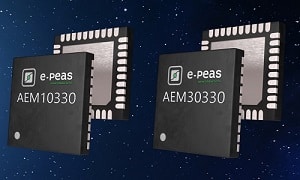The innovative buck-boost architecture allows handling of low battery voltages and offers rapid charging of storage elements

The availability of two new devices, the AEM10330 and AEM30330 power management ICs (PMICs) by e-peas bring new features for energy harvesting applications. An innovative buck-boost architecture helps the devices to deal with low battery voltages. At the same time, high-speed charging of super-capacitors is supervised, which facilitates the supply of more energy to the load that results in greater flexibility when it comes to selecting the storage device.
While the AEM10330 is specifically intended for solar deployments, the AEM30330 is targeted at RF/vibration-oriented deployments (including industrial, home automation, asset tracking and aftermarket automotive monitoring systems, as well as, retail applications).
Both the AEM10330 and AEM30330 have a stand-out characteristic of the cold-start threshold at which they begin to draw energy from the surrounding environment. This is just 275mV/3µW, which is unmatched by any other solution currently available.
The new PMICs can deliver up to 60mA for rapid charging of storage elements. By leveraging the fully configurable maximum power point tracking (MPPT) function, the AEM10330 and AEM30330 can continuously monitor and regulate the input with a fast refresh rate of 20ms. Consequently, the extraction efficiency of the system is high as possible, regardless of input variations from the source.
Adaptive energy management permits these devices to automatically switch between boost, buck-boost and buck operational configurations for optimal energy transfer between the respective inputs and outputs. Furthermore, the power converter can automatically select between three inputs (the harvester, the storage device or a primary battery) and two outputs (the storage device or the application load). The capability of directly transferring harvested energy to the load or the storage element is a unique feature of these PMICs.
With a working temperature range of -40°C to 125°C, these PMICs are supplied in compact 40-pin QFN packages and require only four components to accompany them, which takes up very little board space and gives an ultra-low bill-of-materials.
“Since the release of the initial AEM series PMICs, e-peas has been differentiating itself from the other players in the energy harvesting sector through products with superior performance levels, alongside exceptional application knowledge,” says Christian Ferrier, Chief Marketing Officer at e-peas. “With these latest additions to the series, we are significantly increasing the pervasiveness of our technology, allowing a broader variety of use cases to benefit from it.”






